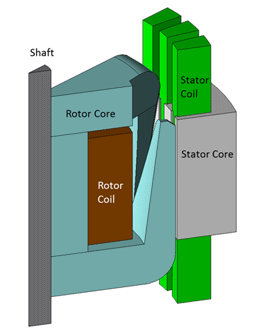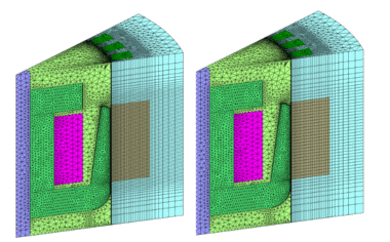Contents
1. Introduction
2. Comparison evaluation of tetrahedral/pentahedral mixed mesh and existing tetrahedral mesh models
3. Summary
1. Introduction
Claw pole alternators are used commonly as alternators for automobiles – due to the unique 3D structure and complicated flow of magnetic flux, the 3D electromagnetic field simulation with the finite element method (FEM) is effective as an evaluation method of output power prediction.
Mesh models for analysis are generally created by automatically generating mesh composed of tetrahedral elements for geometry created with CAD. However, as rotors are solid cores for alternators, they require mesh accounting for skin effect due to eddy current and calculation takes too much time as the number of elements greatly increases. Solving speed rises not only with acceleration of the solver, but also generating mesh appropriate for the analysis model; this is also important in decreasing file size.
This paper looks at tetrahedral/pentahedral mixed mesh and aims to generate effective mesh to reduce calculation time. We compared calculation times and accuracy when analysis is run with conventional tetrahedral mesh, and investigated the effects of division size in the axis direction of pentahedral elements for mixed mesh.
Comparison evaluation of tetrahedral/pentahedral mixed mesh and existing tetrahedral mesh models
Fig. 1 and table 1 show the geometry and analysis specifications of claw pole alternators used in the 3D analysis. The analysis model is a 30-degree model that is 1/12 in the axis direction and is modelled by setting the axial reverse periodic boundary.
Confirming the effects of the mesh size in the extruded direction on the calculation time and accuracy of analysis results is the objective of the analysis when mixed mesh is applied to the alternator. A model that can be used as reference is necessary for the comparison. As the reference, we used a mesh model that has added triangular prism mesh accounting for eddy currents on the rotor surface based on tetrahedral mesh. As the mesh size of the reference, we have adopted a model that has supposedly fully converged when mesh size is assigned.

Fig. 1 Geometry of a claw pole alternator analysis model

Fig. 2 Mesh used for an analysis
You need to sign in as a Regular JMAG Software User (paid user) or JMAG WEB MEMBER (free membership).
By registering as a JMAG WEB MEMBER, you can browse technical materials and other member-only contents for free.
If you are not registered, click the “Create an Account” button.
Create an Account Sign in



